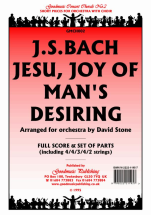Jesu, Joy of Man's Desiring
Buy this item (out of stock)
Product ID: GM1 CH002
By Johann Sebastian Bach
Publisher:
Goodmusic
Arranger:
Stone
Series:
Concert Chorals
Genre:
Baroque
Line Up:
Symphony Orchestra (Solo: Choir)
Duration:
6:30
Set & Score
This item is out of stock
About this item
Bach's original score was for SATB voices and strings, with 2 oboes doubling the first violin part and a trumpet playing the chorale melody. In this version the work can be performed with SATB voices or unison voices (singing the chorale melody), or as a purely instrumental piece. In this last case the minimum requirements are 1 oboe, 2 clarinets and strings and in this instance the oboe should never double the first violins, but should play the 2nd oboe part plus cues. The dynamic markings and bowings are editorial, and the keyboard part incorporates the chorale vocal parts as an aid to rehearsal.
Instrumentation
2 Flutes, 2 Oboes, 2 Clarinets in Bb, Bassoon 2 Horns in F, 2 Trumpets in Bb, Trombone Strings (Violin 1, Violin 2, Viola, Cello, Bass) Piano (optional), Voices (optional)
Reviews and rating
No review available, be the first to write one!

Composer
Johann Sebastian Bach (1685-1750)
Johann Sebastian Bach (21 March 1685, – 28 July 1750) was a German composer, organist, harpsichordist, violist, and violinist whose sacred and secular works for choir, orchestra, and solo instruments drew together the strands of the Baroque period and brought it to its ultimate maturity. Although he did not introduce new forms, he enriched the prevailing German style with a robust contrapuntal technique, an unrivalled control of harmonic and motivic organisation, and the adaptation of rhythms, forms and textures from abroad, particularly from Italy and France.
More info about the composer...



 Click above to view samples
Click above to view samples
